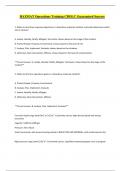HAZMAT Operations Training CBOLC Guaranteed Success
1. What are the three response objectives in a hazardous materials incident, and what determines which
one to choose?
A. Isolate, Identify, Notify, Mitigate, Terminate; chosen based on the stage of the incident
B. Protect People, Property, Environment; chosen based on the level of risk
C. Analyze, Plan, Implement, Evaluate; chosen based on the situation
D. Defensive, Non-Intervention, Offense; chosen based on the level of contamination
**Correct answer: A. Isolate, Identify, Notify, Mitigate, Terminate; chosen based on the stage of the
incident**
2. What are the four operations goals in a hazardous materials incident?
A. Protect People, Property, Environment
B. Analyze, Plan, Implement, Evaluate
C. Isolate, Identify, Notify, Mitigate
D. Defensive, Non-Intervention, Offense
**Correct answer: B. Analyze, Plan, Implement, Evaluate**
Corrosive liquid cargo tanks (412 or 312) ✔️Commonly carries: high density liquids and strong
corrosives
Capacity: 5,000 to 6,000 gal
Pressure: 35 to 50 psi
Small round ends, with access housing coated in BLACK TAR-LIKE MATERIAL, with reinforcement ribs
High pressure cargo tanks (331) ✔️Commonly carries: Liquefied compressed gases such as propane
,Capacity: 2,500 to 11,500 gal
Pressure: 100 to 500 psi
Hemispherical or ellipsoidal ends, with control station at the rear
Compressed gas tube trailers ✔️Commonly carries: Bulk, non-liquefied compressed gasses (noble
gasses)
Capacity: Varies
Pressure: 3,000 to 5,000 psi
Seamless steel cylinders 9 to 48 inches in diameter. All contain the same material and are independently
piped.
Cryogenic liquid cargo tanks (338 or 341) ✔️Commonly carries: cryogenic materials
Capacity: 5,000 to 14,000 gal
Pressure: 23.5 to 500 psi
Tank within tank design, where the tank is the inner vessel and the jacket is the outer shell (insulation).
The ends are "dished"
Cone Roof Tank ✔️Commonly holds: Combustible and flammable liquids, corrosives, oxidizers, and
solvents
Capacity: Will vary
Pressure: 0 to 0.5 psi
Tank with permanent attached, sloped room with weak seams where roof meets sides
Floating Roof W/ Geodesic Dome ✔️Commonly holds: Flammable and combustible liquids
Capacity: 50,000 to over 1,000,000 gal
Pressure: 0 to 0.5 psi
Dome over floating roof design
Floating Roof Tank (Open Floating Roof Tank) ✔️Commonly holds: flammables, combustible, and
corrosive liquids
, Capacity: 50,000 to over 1,000,000 gal
Pressure: 0 to 0.5 psi
Ladder on roof with a roof that actually floats on the liquid surface
✔️Commonly holds: Flammable and combustible liquids
Capacity: Varies
Pressure: 0 to 0.5 psi
Also called internal floating roof, has large vents found at the top of the tank shell to release pressure
Vapor Dome Roof Tank ✔️Commonly holds: Flammable and combustible liquids, molasses and
fertilizers
Capacity: up to 8,500,000
Pressure: 0 to 0.5 psi
Vertical storage tank with a giant bulge or dome on its top, attached to the underside of the dome is a
flexible diaphragm that moves in conjunction with changes in vapor pressure
✔️Commonly holds: bulk storage in conjunction with fuel-dispensing operations, solvents, oxidizers,
poison liquids, and corrosives
Capacity: 300 to 20,000 gallons
Pressure: 0 to 0.5 psi
Flat ends
Noded spheroid ✔️Commonly holds: LPG, methane, propane, and other light gases. May also contain
certain flammable liquids such as gasoline and crude oil
Capacity: varies
Pressure: 0.5 to 15 psi
Looks like a massive balloon/air supported structure
Spheroid ✔️Commonly holds: LPG, methane, propane, and other light gases, it may also contain certain
flammable liquids such as gasoline and crude oil




